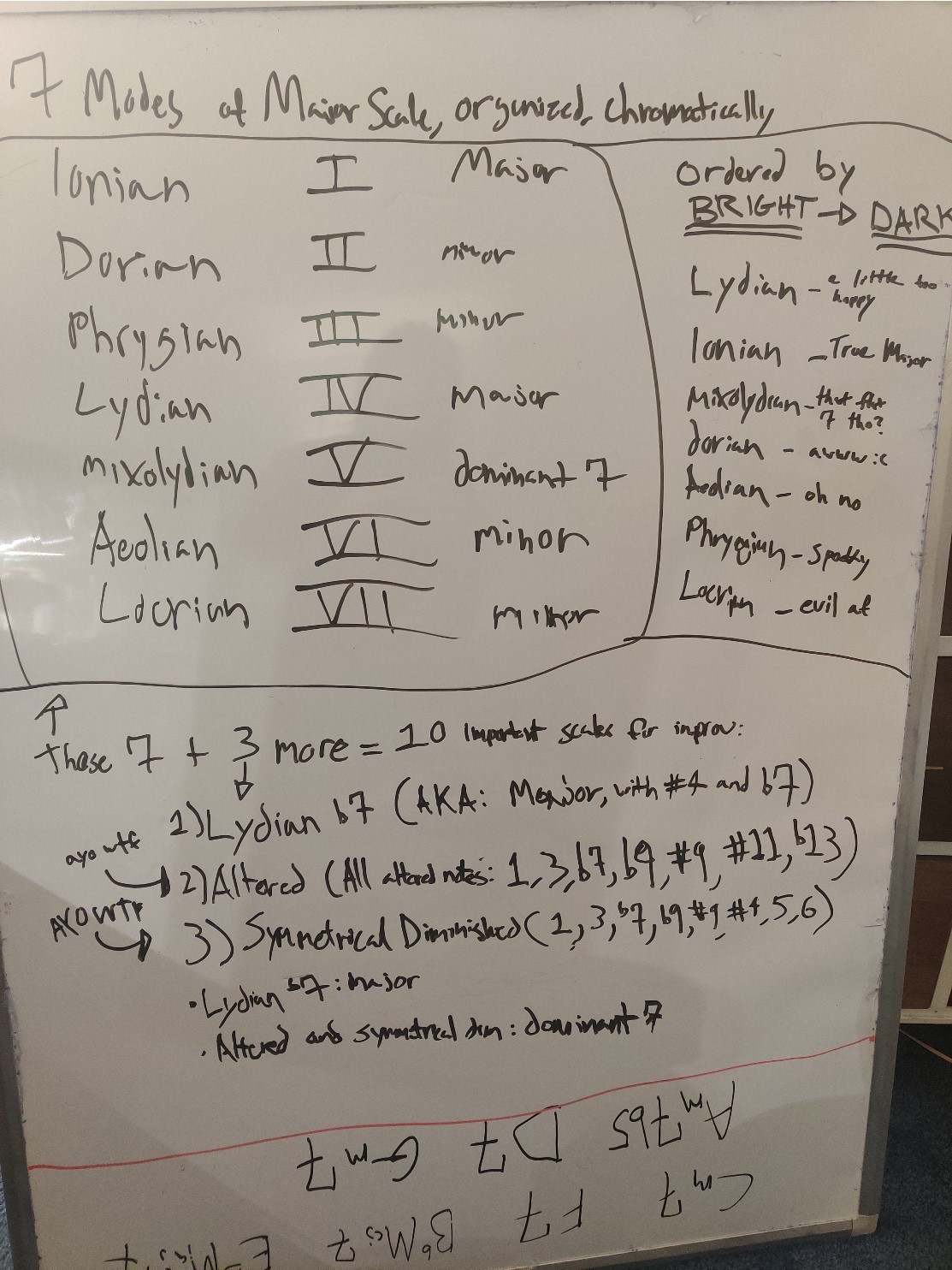10 Scales for Jazz Improvisation - 01/02/2022
Listening to Gary Burton's improvisation lecture (Loyola University, July 2011), learning about 3 new scales, and trying to internalize their relevance within the context of the 7 major modes.
Intro:
This particular lecture has been floating in and out of my YouTube recomendations for the last
several months. I don't have a formal music education, but I've been self-teaching theory for a few years in hopes of becoming a passable pianist. I've been wanting to expand my melodic vocabulary, and this seemed like a great place to start.
For starters. Here are some concepts I knew prior to watching the lecture:
- There are 7 'modes' of the major scale
- Starting from any of the 7 scale degrees will
change the relevance of that scale (if you play C major,
but start from A, your major scale is now a minor scale)
- The 7 modes in chromatic order are:
- Ionian(major)
- Dorian
- Phrygian
- Lydian
- Mixolydian
- Aeolian(minor)
- Locrian
- I also know that some of these modes are 'brighter' or 'darker' in the same way that major and
minor are
Now, here are some of the new and useful things I learned:
- Each of these modes is associated with a chord type. Interestingly, only Lydian, Ionian, and
Mixolydian are associated with Major
- Lydian is even brighter than Major/Ionian
- Locrian is darker than Phrygian
- The 7 modes in order of bright to dark are:
- Lydian
- Ionian(major)
- Mixolydian
- Dorian
- Aeolian(minor)
- Phrygian
- Locrian
That's 7 Scales. What about the other 3?
The remaining 3 scales are a bit more difficult for me to wrap my head around. But the more I think about
them, the more I hear them being used in jazz solos (particularly bebop, e.g. Bobby Timmons' Donna Lee).
(included intervals notated using 1-13, adding b/# (flat/sharp) when necessary)
Lydian b7
- ( 1, 2, 3, #4, 5, 6, b7 )
- This one isn't too crazy- using Lydian mode is just like playing the Major scale,
except you sharp/# the 4th degree. This scale just takes it one step further, adding the flat/b 7th.
- Soloing in Lydian works great over Major chords, but I find it too easily kills the ambiguity
when teasing major vs. minor in a progression (remember: musical tension is merely a high/low mixup. pretend this is street fighter). Adding the b7, however, makes this a bit more compatible
with pentatonic minor licks. Definitely going to try substituting some minor scales with Lydian b7
Altered scale
- ( 1, 3, b7, b9, #9, #11, b13 )
- Mannnnnnnnn I don't know upper extensions like that
- Okay, I know how they work, sort of, but I need to convert in my head to make it easier
- 1, b2, #2, 3, #4, b6, b7
- What makes this scale special is the fact that it includes all possible altered intervals
- This will need more thinking. But initial thoughts are: holy ambiguity, batman
Symmetrical Diminished
- ( 1, 3, #4, 5, 6, b7, b9, #9)
- This one seems even crazier, at first glance. But immediately I recognize that this is actually a scale I use already?
- In my head, when I play with these notes, I'm swinging from one chord type to another- or even changing keys with this
- This feels really natural, because the 3, 5, and 6 lend themselves to major chords
- Meanwhile, the remaining intervals either lend themselves to minor, or something much spookier (e.g. b9 makes me think: phrygian/locrian)
Key takeaways:
- I need to solidify my understanding of upper extensions (9,11,13,including b/#)
- While it feels familiar to use the Symmetrical Diminished scale- it wasn't something I was
particularly conscious of doing. I should try to become more conscious of using it, in an effort
to solidify my understanding of those ideas
- bigger picture- I've actually never listened to somebody talk about musical improvisation
in such a way. It's really satisying to hear the way he talks about it- it enforces my beliefs
about musical improv being the kind of language that can absolutely be taught, and
can be explained in a tangible way (much like how we analyze literature, or even just the mechanics of language themselves)
Anyway. This will be the first of many whiteboard postings to come! I find it helpful to write about
things I am trying to learn/parse/understand. And I think it's worth documenting this learning process, so maybe
somebody out there could read this and be like "wait, did you just call major/minor tension a high/low mixup? do you think music is a fighting game?"
And then I can be like "No no of course not thats crazy hahaaaaa"
- bSharp

